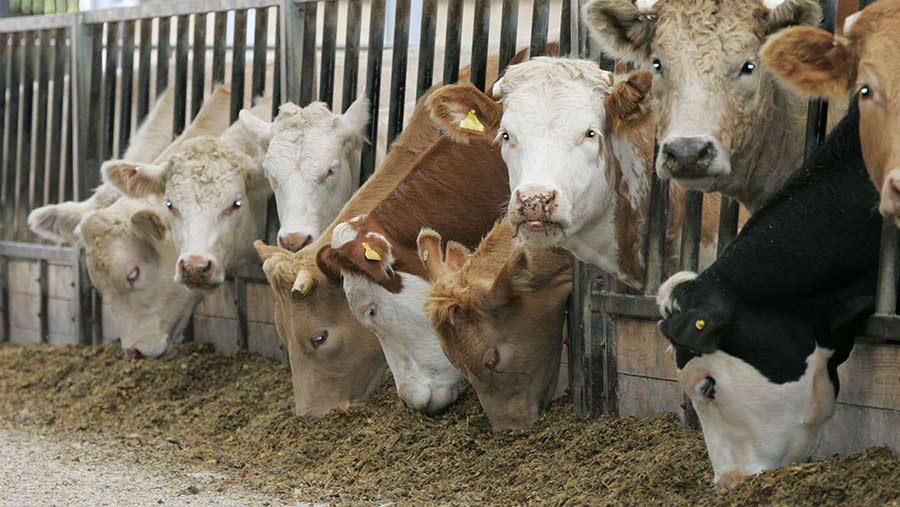Analysis: Are beef prices likely to rise soon?
 © Tim Scrivener
© Tim Scrivener An over-supply of beef is the cause behind falling prices, with a reversal not expected until the majority of finishing stock are turned out and Brexit uncertainty is resolved.
Increased supplies of finished cattle are being sent for slaughter by farmers eager to minimise the number of mouths eating limited forage stocks and expensive finishing rations, with reports of abattoir order books being close to full.
Defra data shows that beef production increased by 4% in February compared with the previous year, with most of the increase coming from prime cattle rather than culls.
See also: Beginners guide to rotational grazing beef suckler herds
AHDB red meat analyst Tom Forshaw said retail demand is also down slightly on the year, and there are reports that significant amounts of beef are in cold storage as processors stockpile to offset the potential risk posed by a no-deal Brexit.
Data from consumer analyst firm Kantar Worldpanel for the past 12 weeks show beef losing ground to pork, chicken and fish, with 2.1m fewer shopping trips resulting in a beef purchase than the same period the previous year, with steak consumption hit hardest.
Mr Forshaw also noted that there are likely to be slightly more beef cattle around, based on British Cattle Movement Service data analysis, which showed increased birth registrations in 2017, leaving more available for slaughter under 30 months now.
Price update
Prime beef prices have now been in near-continuous decline for almost six months, with a brief respite during the Christmas period.
In the week ending 16 March, the average deadweight price for all classes of prime cattle fell by another 3p/kg on the previous week to stand at 336.9p/kg for steers and 338.4p/kg for heifers.
Prices began falling in September 2018, when the all prime average stood at about 370p/kg.
A fall of 30p/kg will have wiped off about £120 from a 400kg carcass, significantly above the average gross margin a head of a number of cattle finishing systems, with the problem compounded by high feed costs through the winter.
The National Beef Association in Northern Ireland has said that the current low prices are unsustainable for the industry, and warned that suckler cow numbers have dropped to their lowest level since 1988.
Mr Forshaw said that a seasonal price uplift was likely in the next month as cattle are turned out to grass, reducing the number being sent for slaughter as more are kept to gain weight more cheaply on grass.
Prices last year began to rise in late March, and saw almost continuous growth from a deadweight base of about 355p/kg to 370p/kg by July.
Processors still unprepared for no-deal scenario
However, this year the normal seasonal fluctuations are being compounded by concerns from processors about access to the export market in the event of a no-deal Brexit.
Despite the UK only being about 70% self-sufficient in beef, around 110,000t was exported last year, chiefly to EU destinations, with Ireland being the chief recipient.
Industry sources say with just days until the UK potentially crashes out of the EU, confusion still reigns regarding vital administrative processes needed for the UK to export meat.
With 60% of cattle slaughtered in the UK and Ireland handled by three companies with a presence in both countries – ABP, Dawn Meats and Kepak – there is concern that rather than export from the UK, they will consign more orders to plants in Ireland, where there is no uncertainty over operations – favouring the Irish meat trade.
This includes the stamp that is required by law to go on each carcass that declares it fit for human consumption, with the Food Standards Agency (FSA) yet to manufacture and distribute the UK stamp that would replace the EU mark.
There are also concerns that there are not a sufficient number of appropriately trained vets available to certify consignments of meat for export.
An FSA spokesman said that the new UK design has been approved and that the agency was working closely with industry to ensure the new stamps are issued to businesses so they can continue to export if the UK leaves the EU without a deal.
Analysis: How likely is it a no-deal Brexit would cause beef prices to rise?
The UK is about 70% self-sufficient in beef, with almost all of the remainder imported from the EU.
According to AHDB analysis, about 73,600t of beef that comes into the UK tariff-free at the moment would be subject to tariffs in the event of a no deal.
This is because the UK has proposed to fix the amount that can come into the country tariff-free to about 230,000t, ending the unlimited access currently enjoyed by other EU member states.
Tariff-free trade between the Republic of Ireland and Northern Ireland will also be allowed to continue, which amounts to an additional 30,000t.
About 340,000t of the 380,000t that were imported last year came from the EU, chiefly from Ireland.
Tariffs have the potential to drive up prices by making domestic beef cheaper to purchase than imports, but other factors will also be at work.
A fall in the value of sterling would also be likely to reduce imports by suppressing the spending power of British businesses in the global marketplace.
However, if beef prices rose, consumers may switch to cheaper cuts or alternative meats rather than accept a price rise that has been passed on to them.
There may also be a rise in the number of cattle imported live for slaughter, as no tariff has been levied on them, but this is unlikely to occur in large numbers as the transportation costs are likely to be prohibitively high.
